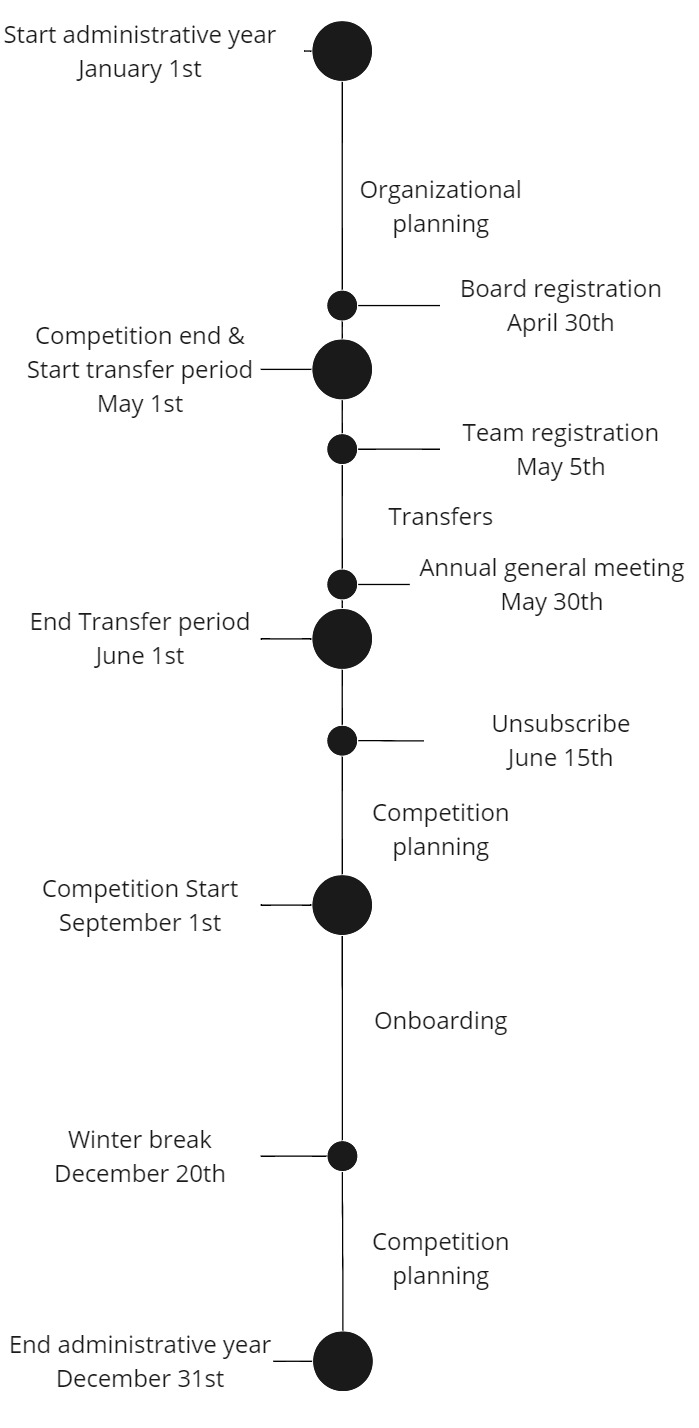It's early january, the second round of the competitive season is about to start. While our athletes and coaches will be focussed on battling it out in the arena, the administrative machinery is already looking forward to next season.
What will the team and supporting organization look like? Who will be taking up key roles in the coming season? Are there any player transfers that have to be taken into account? And what will the sportive agenda and competition look like?
In most clubs, the administrative season follows a different cycle then the competitive one. It starts early in the calendar year and will reach a peak during the, awkwardly called, 'off-season' in the May - September timeframe.

In this post, let's look at what needs to be managed next to the field during a typical administrative season. Whether you are involved in soccer, basketball, volleyball, baseball or any other competitive team sport, a lot of these aspects will apply to your situation too.
Organizational planning
The first few months of the calendar year are very busy times from an organizational planning perspective.
The coordinators need to identify all (potential) members of the club, potentially hundreds of people, and then figure out what their plans and ambitions are for next season.
Will they stay for another year or do they plan to leave? Do they want to stay in their current role, e.g. as a shooting guard on their team? Do they want to transition into another role within the team? Or even pick up something entirely new such as coaching, becoming a referee or board member?
And, of course, the coordinators will also have to check if these members have the skills to perform the desired role.
Once this identification has been performed, the coordinators can start planning a new organizational structure: which teams the club will need, which supportive administrative groups will be required and how these teams or groups will be staffed.
While composing these new teams, skillgaps will be identified: A team may miss some length, or we don't have enough coaches, or the coordinator is burned out by now and refuses to do it all again next year... some recruitment and collaboration with other clubs is needed to fix these gaps.
By the end of the competitive season, the administrative cycle should result in a clear picture of:
- Which key people are committed to take up a role next season
- What the team and board structures will look like
Transfer period
After the competition ends, people are free to transfer between clubs without any conditions for a certain period.
If the coordinators did not identify a key person, that will leave, this period can have disastrous effects on the upcoming season.
This potential problem is further aggrevated by specific deadlines that fall very early in this timeframe:
- All teams need to be registered only a few days into the transfer period, without knowing their exact roster composition.
- The board must be registered at the league up front, while the legal deadline for this same registration at the government is only at the end of the period. Tip: move your annual general meeting to earlier the season to avoid this problem.
If all goes well, this period is only marked with a high workload for the secretary and communication team. Filling out the necessary paper work and communicating with all new and existing members.
After the transfer period there is a small time window, just 15 days, in which clubs can unsubscribe players that have indicated to stop competing. This is an important, yet often overlooked, task that can save the club quite some registration costs.
Note that the transfer period only encompasses voluntary transfers. Even when this period ended, players can still transfer if both the origin and destination clubs agree to it. For clubs with a high degree of collaboration, it's quite common to see players transfer all summer or even later in the year.
Planning the competition
During the summer months, while the athletes are showing off their muscled bodies on the beach, the administrative team will be hard at work preparing the upcoming competitive season. Tasks include:
- registering team rosters,
- arranging dual licenses for certain players (of other clubs),
- requesting coaching licenses,
- registering results of medical checkups,
- planning games,
- finding additional (practice) facilities
- ...
This work has to be finished before the first game of a team occurs.
Luckily not all age groups start at the same time, so it can be approached in a staggered way.
Onboarding new members
The younger age groups start their competitive season a little later.
This is due to the high inflow of new members at the ages 5 to 12 at the start of the competitive season.
They want to give their new sport a try for a while, before they'll commit to an entire season.
For the remainder of the administrative season, most of the workload is signing up these new members.
Once the first round of competition is well on it's way the work will diminish and the administrative team can finally take a short break, either on a beach on the other side of the planet or, more likely, watching the games they worked so hard on.
Second round planning
During winter break there is again a small window where the second round of games needs to be planned.
Marking the start of the next administrative cycle...